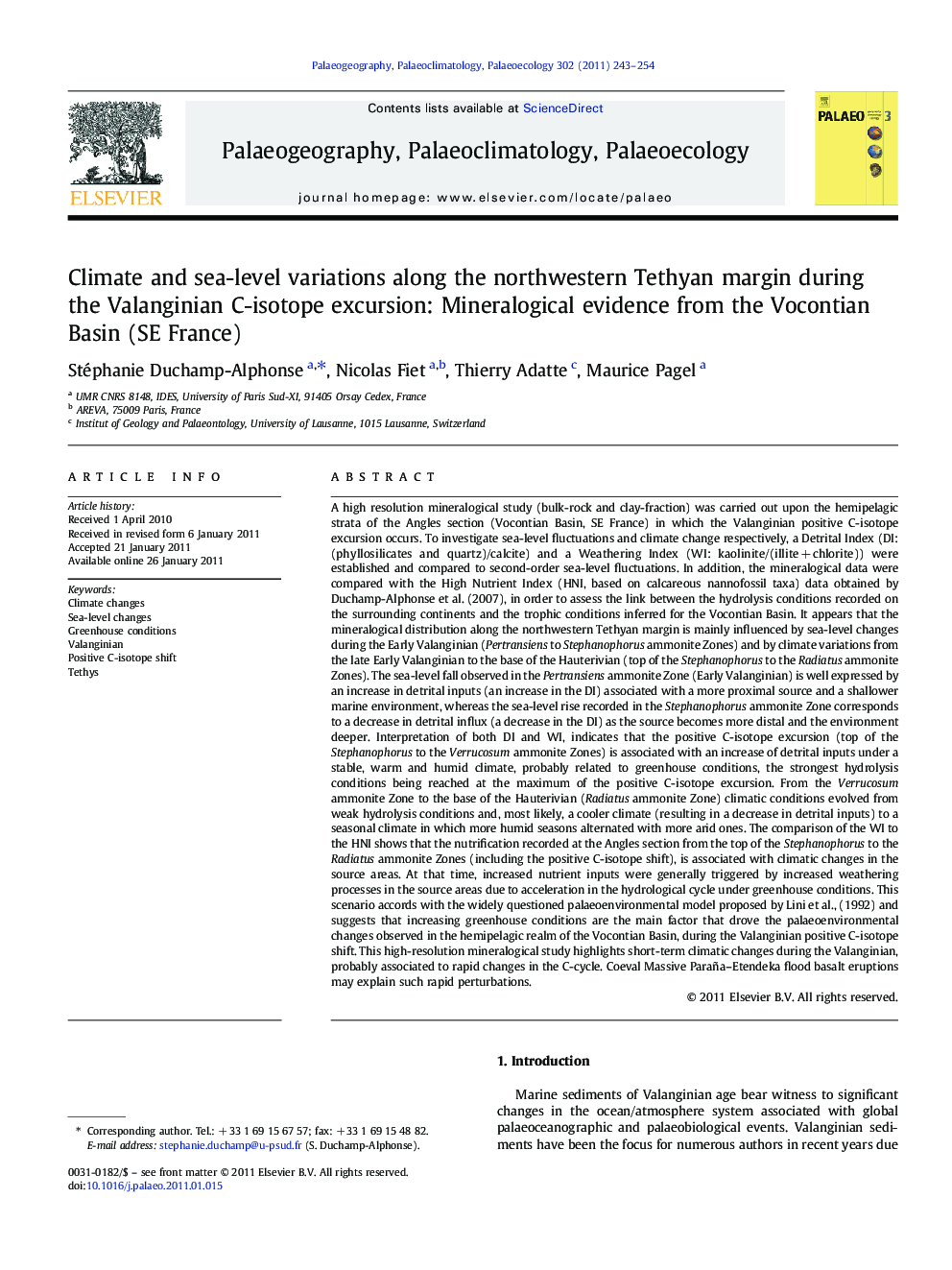| کد مقاله | کد نشریه | سال انتشار | مقاله انگلیسی | نسخه تمام متن |
|---|---|---|---|---|
| 4467194 | 1622260 | 2011 | 12 صفحه PDF | دانلود رایگان |

A high resolution mineralogical study (bulk-rock and clay-fraction) was carried out upon the hemipelagic strata of the Angles section (Vocontian Basin, SE France) in which the Valanginian positive C-isotope excursion occurs. To investigate sea-level fluctuations and climate change respectively, a Detrital Index (DI: (phyllosilicates and quartz)/calcite) and a Weathering Index (WI: kaolinite/(illite + chlorite)) were established and compared to second-order sea-level fluctuations. In addition, the mineralogical data were compared with the High Nutrient Index (HNI, based on calcareous nannofossil taxa) data obtained by Duchamp-Alphonse et al. (2007), in order to assess the link between the hydrolysis conditions recorded on the surrounding continents and the trophic conditions inferred for the Vocontian Basin. It appears that the mineralogical distribution along the northwestern Tethyan margin is mainly influenced by sea-level changes during the Early Valanginian (Pertransiens to Stephanophorus ammonite Zones) and by climate variations from the late Early Valanginian to the base of the Hauterivian (top of the Stephanophorus to the Radiatus ammonite Zones). The sea-level fall observed in the Pertransiens ammonite Zone (Early Valanginian) is well expressed by an increase in detrital inputs (an increase in the DI) associated with a more proximal source and a shallower marine environment, whereas the sea-level rise recorded in the Stephanophorus ammonite Zone corresponds to a decrease in detrital influx (a decrease in the DI) as the source becomes more distal and the environment deeper. Interpretation of both DI and WI, indicates that the positive C-isotope excursion (top of the Stephanophorus to the Verrucosum ammonite Zones) is associated with an increase of detrital inputs under a stable, warm and humid climate, probably related to greenhouse conditions, the strongest hydrolysis conditions being reached at the maximum of the positive C-isotope excursion. From the Verrucosum ammonite Zone to the base of the Hauterivian (Radiatus ammonite Zone) climatic conditions evolved from weak hydrolysis conditions and, most likely, a cooler climate (resulting in a decrease in detrital inputs) to a seasonal climate in which more humid seasons alternated with more arid ones. The comparison of the WI to the HNI shows that the nutrification recorded at the Angles section from the top of the Stephanophorus to the Radiatus ammonite Zones (including the positive C-isotope shift), is associated with climatic changes in the source areas. At that time, increased nutrient inputs were generally triggered by increased weathering processes in the source areas due to acceleration in the hydrological cycle under greenhouse conditions. This scenario accords with the widely questioned palaeoenvironmental model proposed by Lini et al., (1992) and suggests that increasing greenhouse conditions are the main factor that drove the palaeoenvironmental changes observed in the hemipelagic realm of the Vocontian Basin, during the Valanginian positive C-isotope shift. This high-resolution mineralogical study highlights short-term climatic changes during the Valanginian, probably associated to rapid changes in the C-cycle. Coeval Massive Paraña–Etendeka flood basalt eruptions may explain such rapid perturbations.
Research Highlights
► Bulk rock and clay mineral indices as sea-level and climate proxis.
► Regression-transgression couplet during the Early Valanginian.
► Rapid climate changes during the Late Valanginian.
► Valanginian positive C-isotope excursion associated with a warm and humid climate.
► Nutrification triggered by hydrolisis conditions.
Journal: Palaeogeography, Palaeoclimatology, Palaeoecology - Volume 302, Issues 3–4, 15 March 2011, Pages 243–254